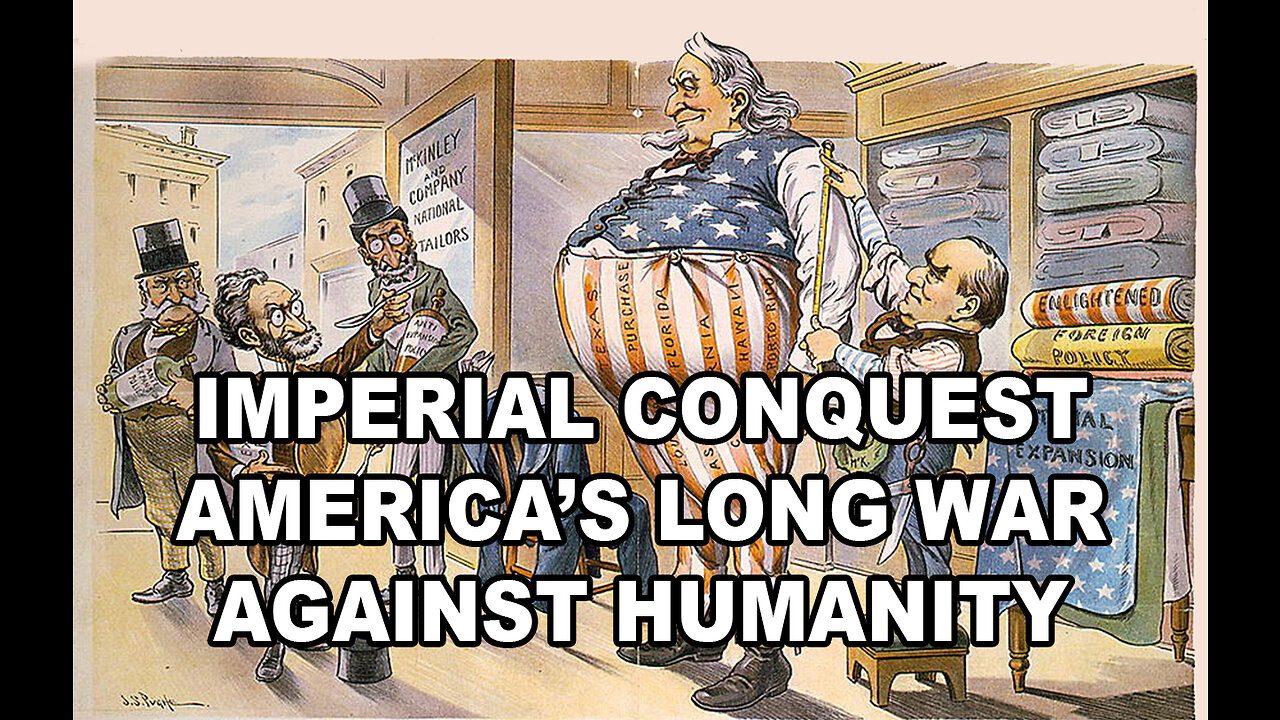Premium Only Content

Imperial Conquest: America’s “Long War” Against Humanity - Worldwide Militarization
Imperial Conquest: America’s “Long War” Against Humanity - Worldwide Militarization
Nov. 17, 2023
By Professor Michel Chossudovsky
The following text was first presented at the Rosa Luxemburg Conference, Berlin, January 11, 2014. It was subsequently included in my book entitled The Globalization of War. America’s Long War against Humanity.
The concept of the Long War is part of U.S. military doctrine since the end of World War II. In many regards, today’s wars are a continuation of the Second World War.
Worldwide militarization is also part of a global economic agenda, namely the application of the neoliberal economic policy model which has led to the impoverishment of large sectors of the world population.
Of utmost relevance to an understanding of the war in Ukraine, the genocide against Palestine and the unfolding war in the Middle East.
Introduction
The world is at the crossroads of the most serious crisis in modern history. The U.S. has embarked on a military adventure, “a long war”, which threatens the future of humanity. This “war without borders” is being carried out at the crossroads of the most serious economic crisis in World history, which has been conducive to the impoverishment of large sectors of the World population.
The Pentagon’s global military design is one of world conquest. The military deployment of U.S.-NATO forces is occurring in several regions of the world simultaneously.
The concept of the “Long War” has characterized U.S. military doctrine since the end of World War II.
Worldwide militarization is part of a global economic agenda.
Militarization at the global level is instrumented through the U.S. military’s Unified Command structure: the entire planet is divided up into geographic Combatant Commands under the control of the Pentagon. U.S. Strategic Command (USSTRATCOM) Headquarters in Omaha, Nebraska plays a central role in coordinating military operations.
According to former NATO Commander General Wesley Clark, the Pentagon’s military road-map consists of a sequence of war theatres:
“[The] five-year campaign plan [includes]… a total of seven countries, beginning with Iraq, then Syria, Lebanon, Libya, Iran, Somalia and Sudan.” (Democracy Now, 2007)
The ongoing war on Syria is a stepping stone towards a war on Iran, which could lead to a process of military escalation.
Russia and China, which are allies of both Syria and Iran, are also targeted by U.S.-NATO. In the wake of the Cold War, nuclear weapons are no longer a weapon of last resort (deterrence), their use is now contemplated in the conventional war theatre.
The road to Tehran goes through Damascus. A U.S.-NATO sponsored war on Iran would involve, as a first step, a destabilization campaign (“regime change”) including covert intelligence operations in support of Al Qaeda affiliated rebel forces directed against the Syria.
The geopolitics of oil and oil pipelines is crucial in the conduct of these military operations. The broader Middle East- Central Asian region encompasses more than 60 percent of the World’s oil reserves.
There are at present five distinct war theatres in the Middle East Central Asian region: Afghanistan-Pakistan, Iraq, Palestine, Libya and Syria.
An all out military attack on Syria would lead to the integration of these separate war theaters, eventually leading towards a broader Middle East-Central Asian war, engulfing an entire region from North Africa and the Mediterranean to Afghanistan, Pakistan and China’s Western frontier.
“Waging a War without Borders”: The 2000 Project for the New American Century (PNAC).
This project was first formulated by the Neocons in September 2000
The PNAC’s declared objectives were to “fight and decisively win multiple, simultaneous major theater wars” in different regions of the world as well as perform the so-called military “constabulary” duties “associated with shaping the security environment in critical regions.”
Military actions are implemented simultaneously in different regions of the world (as outlined in the PNAC) as well as sequentially.
Global constabulary implies a worldwide process of military policing and interventionism, including covert operations and “regime change”, all of which are carried out in accordance with a “humanitarian mandate”.
This military agenda undertaken under the banner of “Responsibility to Protect” largely prevails under the Obama presidency.
Media propaganda has been instrumental is sustaining the fiction of humanitarian warfare.
The Legacy of World War II. Demise of Competing Imperialist powers
What is referred euphemistically as the “post war era” is in fact a period of continuous wars and militarization. This must be understood when focussing on contemporary U.S. led wars. While commemorating World War I, it is also important to understand that there is a continuum of U.S. military strategies going back to World War I and the inter-war period.
The U.S. emerges in the wake of the Second World War unscathed. Most of the fighting was conducted by its allies, a strategy which the U.S. has used consistently in post-world war II conflicts. Moreover, a careful examination of World War II suggests that U.S. corporate interests including Rockefeller’s Standard Oil supported both its allies and its enemies including Nazi Germany well beyond the U.S.’s entry into World War II in 1941. The strategic objective was to weaken both sides, namely to destabilize competing imperialist powers.
Emerging as the victor nation in the wake of World War II, the U.S. has determined the political and economic contours of post-War Western Europe. U.S. troops are stationed in several European countries. Both its World War II adversaries (Germany, Japan, Italy) as well as its allies (France, U.K. Belgium, the Netherlands) have been weakened. With the exception of the U.K. which is part of the Anglo-American axis, these countries are outgoing colonial powers, displaced by U.S. hegemony. Their pre-World War II colonial territories including Indonesia, The Congo, Indochina, Rwanda (among others) have been gradually integrated over a period of half a century into a dominant U.S. sphere of influence.
In Africa, the process of displacement of France’s sphere of influence is still ongoing. The U.S. is currently taking over the control of France and Belgium’s former colonies in Central Africa and West Africa. Washington also exerts a decisive role in the Maghreb.
“Internal Colonialism” in the European Union
A complex form of “internal colonialism” is also emerging in the European Union. U.S. financial institutions and business conglomerates together with their European partners are prevalent in setting both the monetary, trade and investment agenda.
Politics are subordinated to dominant financial interests. What is also unfolding in terms of secret trade negotiations (under the TTIP and CETA), is a process of economic and political integration between the EU and North America. These agreements together with the Trans-Pacific Partnership (TPP) constitute the building blocks of a process of global economic domination.
Meanwhile, presidential and parliamentary elections in the EU, including Germany, Italy and France (e.g. Sarkozy and Hollande) are increasingly the object of covert political interference (modeled on the color revolutions), namely U.S. sponsored regime change. The fundamental question is to what extent are European leaders political proxies.
U.S.-Sponsored Wars and Military Intelligence Operations
This entire period (1945- present) has been marked by a succession of U.S. sponsored wars and military-intelligence interventions in all major regions of the World.
We are not dealing with piecemeal military operations pertaining to specific countries and regions: There is a military roadmap, a sequence of military operations. Non-conventional forms of intervention including State sponsored terrorist attacks rather than theater war have also been launched.
America’s war is a cohesive and coordinated plan of Worldwide military conquest which serves dominant financial and corporate interests. The structure of alliances including NATO is crucial.
The European Union plays a central role in this military agenda. The member states of the EU are allies of the Anglo-American axis, but at the same time, a restructuring process is occurring within the EU, whereby previously sovereign countries are increasingly under the jurisdiction of powerful financial institutions.
The imposition of the IMF’s deadly economic reforms on several European countries is indicative of America’s interference in European affairs. What is at stake is a major shift in EU political and economic structures, whereby member states of the EU are de facto re-categorized by the IMF and treated in the same way as an indebted Third World country.
Military Strategy
While the U.S. has intervened militarily in major regions of the World, the thrust of U.S. foreign policy is to have these wars fought by America’s allies or to resort to non-conventional forms of warfare.
The thrust of this agenda is twofold:
1) U.S. military might is coupled with that of “Global NATO” including Israel. We are dealing with a formidable force, in terms of advanced weapons systems. U.S. military bases have been established in all major regions of the World under the geographical command structure. A new African command has been established.
2) Military action supports powerful economic and financial interests. A strategy of “Economic Warfare” under the neoliberal agenda is implemented in close coordination with military planning.
The purpose of warfare is not conquest per se. The U.S. lost the Vietnam war, but the ultimate objective was to destroy Vietnam as a sovereign country.
Vietnam together with Cambodia today constitute a new impoverished frontier of the global cheap labor economy.
The imperial project is predicated on economic conquest, implying the confiscation and appropriation of the wealth and resources of sovereign countries. In the Middle East, successive wars have been geared towards the confiscation of oil and gas reserves.
Countries are destroyed, often transformed into territories, sovereignty is foregone, national institutions collapse, the national economy is destroyed through the imposition of “free market” reforms under the helm of the IMF, unemployment becomes rampant, social services are dismantled, wages collapse, and people are impoverished.
The ruling capitalist elites in these countries are subordinated to those of the U.S. and its allies. The nation’s assets and natural resources are transferred into the hands of foreign investors through a privatization program imposed by the invading forces.
Historical Background: Nuclear Weapons. The Legacy of Hiroshima and Nagasaki
America’s early nuclear weapons doctrine under the Manhattan Project was not based on the Cold War notions of “Deterrence” and “Mutually Assured Destruction” (MAD). Contemporary post Cold War U.S. nuclear doctrine is based on the notion that nuclear weapons can be used in the conventional war theater and that these weapons are “harmless to civilians”.
The strategic objective in the use of both conventional and nuclear attacks has been to trigger “mass casualty producing events” resulting in tens of thousands of deaths.
This strategy first applied during World War II in Japan and Germany was to terrorize an entire nation, as a means of military conquest.
In Japan, military targets were not the main objective: the notion of “collateral damage” was used as a justification for the mass killing of civilians, under the official pretence that Hiroshima was “a military base” and that civilians were not the target.
In the words of president Harry Truman:
“We have discovered the most terrible bomb in the history of the world. … This weapon is to be used against Japan … [We] will use it so that military objectives and soldiers and sailors are the target and not women and children. Even if the Japs are savages, ruthless, merciless and fanatic, we as the leader of the world for the common welfare cannot drop that terrible bomb on the old capital or the new. … The target will be a purely military one…
“It seems to be the most terrible thing ever discovered, but it can be made the most useful.” 20 (President Harry S. Truman, Diary, July 25, 1945)
“The World will note that the first atomic bomb was dropped on Hiroshima a military base. That was because we wished in this first attack to avoid, insofar as possible, the killing of civilians..” (President Harry S. Truman in a radio speech to the Nation, August 9, 1945).
[Note: The first atomic bomb was dropped on Hiroshima on August 6, 1945; the Second on Nagasaki, on August 9, on the same day as Truman’s radio speech to the Nation]
Nobody within the upper echelons of the U.S. government and military believed that Hiroshima was a military base, Truman was lying to himself and to the American public.
To this day, the use of nuclear weapons against Japan is justified as a necessary cost for bringing the war to an end and ultimately “saving lives”.
Prior to Hiroshima, the U.S. extensively used fire bombs in Japan resulting in large civilian casualties. In Germany, allied forces extensively bombed and destroyed German cities in the latter part of the war targeting civilians rather than military installations.
The U.S. nuclear weapons arsenal has grown considerably. In the post Cold era, ArmsControl.org (April 2013) confirms that the United States
“possesses 5,113 nuclear warheads, including tactical, strategic, and non-deployed weapons.”
According to the latest official New START declaration, out of more than 5113 nuclear weapons,
“the U.S. deploys 1,654 strategic nuclear warheads on 792 deployed ICBMs, SLBMs, and strategic bombers…
Moreover, according to The Federation of American Scientists (FAS) the U.S. possesses 500 tactical nuclear warheads, many of which are deployed in non-nuclear states including Germany, Italy, Turkey, Belgium, the Netherlands.
The History of War Crimes
The notion of mass casualty producing events prevails to this date in U.S. military strategies. Invariably, as in the case of Syria, the civilian casualties of war committed by the aggressor are blamed on the victims.
The period extending from the Korean war to the present is marked by a succession of U.S. sponsored theatre wars (Korea Vietnam, Cambodia, Afghanistan, Iraq, and Yugoslavia), various forms of military intervention including low intensity conflicts, “civil wars” (The Congo, Angola, Somalia, Ethiopia, Rwanda, Sudan), military coups, U.S. sponsored death squadrons and massacres (Chile, Guatemala, Honduras, Argentina, Indonesia, Thailand, Philippines), covert wars led by U.S. intelligence, U.S.-NATO sponsored military intervention in Libya (using Al Qaeda rebels as their foot soldiers sponsored by Western intelligence).
The war on Syria is essentially a covert war of aggression whereby the Western military alliance and its GCC partners are supporting a terrorist insurgency. The objective is to destabilize Syria as a nation state.
The objective has not been to win these wars but in essence to destabilize these countries as nation states as well as impose a proxy government which acts on behalf of Western interests. Accounting for these various operations, the United States has attacked, directly or indirectly, some 44 countries in different regions of the developing world, since August 1945, a number of them many times (Eric Waddell, 2003):
“The avowed objective of these military interventions has been to effect ‘regime change’. The cloaks of “human rights” and of “democracy were invariably evoked to justify what were unilateral and illegal acts.” (Eric Waddell, 2003)
Destroying Internationalism: The Truman Doctrine
The broader objective of global military dominance in the wake of World War II in support of an imperial project was formulated under the Truman administration in the late 1940s at the outset of the Cold War. It was reaffirmed by U.S. President George Herbert Walker Bush in a historical 1990 address to a joint session of the U.S. Congress and the Senate in which he proclaimed a New World Order emerging from the downfall of the Berlin Wall and the disintegration of the Soviet block.
The ideological underpinning of this agenda are to be found in what is known as the “Truman Doctrine”, first formulated by foreign policy adviser George F. Kennan in a 1948 in a State Department brief.
What this 1948 document conveys is continuity in U.S. foreign policy, from “Containment” during the Cold War to “Pre-emptive” Warfare and “War on Terrorism”. It states in polite terms that the U.S. should seek economic and strategic dominance through military means:
Furthermore, we have about 50% of the world’s wealth but only 6.3% of its population. This disparity is particularly great as between ourselves and the peoples of Asia. In this situation, we cannot fail to be the object of envy and resentment. Our real task in the coming period is to devise a pattern of relationships which will permit us to maintain this position of disparity without positive detriment to our national security. To do so, we will have to dispense with all sentimentality and day-dreaming; and our attention will have to be concentrated everywhere on our immediate national objectives. We need not deceive ourselves that we can afford today the luxury of altruism and world-benefaction. (…)
In the face of this situation we would be better off to dispense now with a number of the concepts which have underlined our thinking with regard to the Far East. We should dispense with the aspiration to “be liked” or to be regarded as the repository of a high-minded international altruism. We should stop putting ourselves in the position of being our brothers’ keeper and refrain from offering moral and ideological advice. We should cease to talk about vague and—for the Far East—unreal objectives such as human rights, the raising of the living standards, and democratization. The day is not far off when we are going to have to deal in straight power concepts. The less we are then hampered by idealistic slogans, the better (George f. Kennan, 1948 State Department Brief)
The planned disintegration of the United Nations system as an independent and influential international body has been on the drawing board of U.S. foreign policy since the inception of the United Nations in 1946. Its planned demise was an integral part of the Truman doctrine as defined in 1948. From the very inception of the UN, Washington has sought on the one hand to control it to its advantage, while also seeking to weakening and ultimately destroy the UN system.
In the words of George Kennan:
“Occasionally, it [the United Nations] has served a useful purpose. But by and large it has created more problems than it has solved, and has led to a considerable dispersal of our diplomatic effort. And in our efforts to use the UN majority for major political purposes we are playing with a dangerous weapon which may some day turn against us. This is a situation which warrants most careful study and foresight on our part. (George Kennan, 1948)
Although officially committed to the “international community”, Washington has largely played lip service to the United Nations. Today the UN is in many regards an appendage of the U.S. State apparatus.
Rather than undermining the UN as an institution, the U.S. and its allies exert control over the Secretariat and key UN agencies. Since Gulf War I, the UN has largely acted as a rubber stamp. It has closed its eyes to U.S. war crimes, it has implemented so-called peacekeeping operations on behalf of the Anglo-American invaders, in violation of the UN Charter. Following the de facto “dismissal” of Secretary General Boutros Boutros Ghali, UN Secretaries General Kofi Annan and Ban ki Moon have became a tool of U.S. foreign policy, taking their orders directly from Washington.
Building a U.S. Sphere of Influence in East and South East Asia
The Truman doctrine discussed above was the culmination of a post World War II U.S. military strategy initiated with the nuclear bombing of Hiroshima and Nagasaki in August 1945 and the surrender of Japan.
In East Asia it consisted in the post-war occupation of Japan as well the U.S. takeover of Japan’s colonial Empire including South Korea (Korea was annexed to Japan under the 1910 Japan–Korea Annexation Treaty).
Following Imperial Japan’s defeat in World War II, a U.S. sphere of influence throughout East and South East Asia was established in the territories of Japan’s former “Great East Asia Co-Prosperity Sphere”.
America’s hegemony in Asia was largely based on establishing a sphere of influence in countries under the colonial jurisdiction of Japan, France and the Netherlands.
The U.S. sphere of influence in Asia –which was built up over a period of more than 20 years– included the Philippines (a U.S. possession which was occupied by Japan during World War II), South Korea (annexed to Japan in 1910), Thailand (a Japanese protectorate during World War II), Indonesia (a Dutch colony occupied by Japan during World War II, which becomes a de facto U.S. proxy State following the establishment of the Suharto military dictatorship in 1965).
This U.S. sphere of influence in Asia also extended its grip into France’s former colonial possessions in Indochina, including Vietnam, Laos and Cambodia, which were under Japanese military occupation during World War II.
Obama’s “Pivot to Asia” which overtly threatens China is the endgame of this historical process.
The Korean War (1950-1953) was the first major military operation undertaken by the U.S. in the wake of World War II, launched at the very outset of what was euphemistically called “The Cold War”. In many respects it was a continuation of World War II, whereby Korean lands under Japanese colonial occupation were, from one day to the next, handed over to a new colonial power, the United States of America.
In South Korea on September 8, 1945, three weeks after the surrender of Japan on August 15th 1945. Moreover, Japanese officials in South Korea assisted the U.S. Army Military Government (USAMG) (1945-48) led by General Hodge in ensuring this transition. Japanese colonial administrators in Seoul as well as their Korean police officials worked hand in glove with the new colonial masters.
While Japan was treated as a defeated Empire, South Korea was identified as a colonial territory to be administered under U.S. military rule and U.S. occupation forces. America’s handpicked appointee Sygman Rhee was flown into Seoul in October 1945, in General Douglas MacArthur’s personal airplane.
The bombing raids directed against civilians in Japan and Germany at the end of World War II as well as the War on Korea (1950-53) had set the stage for the implementation of mass casualty producing events: extensive crimes were committed by U.S. forces. U.S. Major General William F Dean “reported that most of the North Korean cities and villages he saw were either rubble or snow-covered wastelands”
General Curtis LeMay [left] who coordinated the bombing raids against North Korea brazenly acknowledged that:
“Over a period of three years or so we killed off – what – twenty percent of the population. … We burned down every town in North Korea and South Korea, too”.
According to Brian Willson:
It is now believed that the population north of the imposed 38th Parallel lost nearly a third its population of 8 – 9 million people during the 37-month long “hot” war, 1950 – 1953, perhaps an unprecedented percentage of mortality suffered by one nation due to the belligerence of another.”
North Korea has been threatened of an attack with U.S. nuclear weapons for more than 60 years.
READ MORE: https://michelchossudovsky.substack.com/p/imperial-conquest-america-long-war-humanity
VIDEO from, Rosa Luxemburg Conference, Berlin, January 11, 2014 - Original: https://youtu.be/H0_oDYFlUW0
-
 LIVE
LIVE
JULIE GREEN MINISTRIES
1 hour agoLIVE WITH JULIE
16,616 watching -
 LIVE
LIVE
Welcome to the Rebellion Podcast
11 hours agoDon3po is Live - WTTR Podcast Live 9/4
417 watching -
 13:43
13:43
The Kevin Trudeau Show Limitless
22 hours agoClassified File 3 | Kevin Trudeau EXPOSES Secret Society Brainwave Training
44.5K9 -
 LIVE
LIVE
The Chris Salcedo Show
12 hours agoAmericans Are Tired Of Leftists & Fake-GOP Who Cater To Them
673 watching -
 LIVE
LIVE
Game On!
19 hours ago $0.94 earnedFootball IS BACK! Cowboys vs Eagles Opening Night Kickoff!
3,505 watching -
 LIVE
LIVE
The Bubba Army
22 hours ago#1 Documentary IN THE WORLD! - Bubba the Love Sponge® Show | 9/04/25
2,934 watching -
 39:31
39:31
Her Patriot Voice
14 hours ago $1.07 earnedBlack Conservative Surrounded + ROBBED By Leftists!
4.27K22 -
 13:25
13:25
The Gun Collective
14 hours agoWOW! A LOT of new GUNS just dropped!
12.7K7 -
 LIVE
LIVE
BEK TV
23 hours agoTrent Loos in the Morning - 9/04/2025
217 watching -
 8:13
8:13
Geoff_Tac
1 day agoMAC 1014 Shotgun (Benelli Clone)
2.54K2